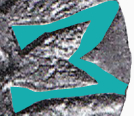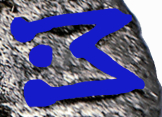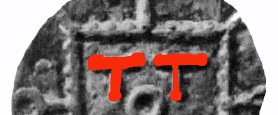Runic Series Sceatta Type Classification
R Series Type 3


ID 24 Timms Collection
As with the R8 Sceatta survey I have conducted this survey to establish a system of identification that I can use with my collection, as I couldn't find a detailed one in existence that met my requirements. Use the images on the Corpus and ID Chart page to identify your coin then follow the links for further information.
The R3 coins were struck at the beginning of the reign of King Ælfwald (713AD to 749AD) somewhere in his kingdom of East Anglia, the exact location still remains a mystery. Hutcheson A R J PhD UEA 2009 comments “…...There are, to summarise, at least two and probably three separate sequences of Series R types. Metcalf suggests that those coins with the epa, xepa or gepa inscriptions were predominantly minted at Ipswich or Woodbridge…..”. R3 coins have GEPA or EPA, on some coins the X or “G” is not at all obvious. Hutcheson further comments that “Metcalf suggests that Series R is likely to have been the royal coinage of King Ældwulf (AD 663/4–c.713) and his son and successor King Ælfwald (c.AD 713–49) “. The R3 was most probably struck at the beginning of the reign of Ælfwald. Blackburn’s Chronology in Abramson 2012 gives the date of the “R” series as ranging from 710 to 750, virtually co-terminal with Ælfwald’s reign.
This study attempts to classify the different styles of artwork on both the obverse and reverse of the R3 Sceatta. The R3 is given the identification numbers of S/1/11/30 & S/1/11/40 by Abramson (see Sceatta List) and in Spink is given the number 813. The Rigold/Metcalf “R3” (R for Runic) designation is most commonly used by dealers/collectors. In Sylloge 63 Gannon identifies the coins only as “Series R, Busts with Pyramidal neck” (640/641 Plate 27)
Coins images studied come from the British Museum Sylloge 63 Gannon (2 coins), Thrymsas & Sceattas Metcalf (5 coins), the Early Medieval Corpus at the Fitzwilliam Museum Cambridge (7 coins), the collection of Dr T Abramson (4 coins) and my collection Timms (6 coins). One coin from my personal collection not registered on the EMC is also included. Coins without a find spot cannot be registered on the EMC database. Twenty Four coins have been observed. My thanks to Dr T Abramson for permission to use images of his coins.
Find Spots
The County with the most recorded find spots was Norfolk with six finds (25%), there were also seven coins with no find spot (29.2%). East Anglia, Suffolk, Cambridgeshire and Essex all had two finds (8.3% each). There were single finds in Lincolnshire, Tyne & Wear and Kent (4.2% each)
There is a wide distribution of known find spots ranging from Tyne & Wear in the north east of England to Kent in the south east. The main grouping (if Essex is included) is centred on “East Anglia” (Norfolk, Suffolk Cambridgeshire and Essex), fourteen coins (58.3%). Some of the seven “no find spot coins” may well have also come from East Anglia.
Weight
Weights were recorded on 23 of the 24 descriptions. The weight ranged from 0.80g up to 1.25g. The median weight for the 23 coins was 1.02g.
The weights of the five coins with the head facing Left ranged from 0.86g to 1.20g, with a median of 1.07g. ID1 was 0.86g, ID 9 was 1.20g, ID 14 1.15g, ID 20 1.10g and ID 21 1.04g.
The eighteen Right facing coins (with weights recorded) ranged from 0.80g to 1.25g, no weight for coin ID3 was recorded. The median for the 18 Right facing coins was 1.006g.
Some elements of the iconography extend over the side of the flan in an offset strike making exact observation impossible. Some of the coins have had a hard time during their “currency” life and others similar during their “buried” life, neither experiences aid identification 1300 years later!

Obverse Iconography
The strike on the obverse of all of the coins observed is quite centrally placed. Some of the coins have offset strikes on the reverse, ID 1, ID 3, ID 10 and ID 12. On all coins having a horizontal chevron, the chevron always points towards the head. See above in blue.
Crown
All coins with the exception of ID 17 have two “crown” lines. See above in green. Only ID 8 has a Crown clearly visible, ID 1 has possibly some Crown visible but this is not clear at all.
Runic Head
The Runic head on all R3 coins has the typical “two-line” pointed nose of the early R series. See above in red. The Runic head faces Right on 19 of the 24 coins observed (76.2%) and left on 5 (20.8%). I have used this as one of the characteristics in determining different types.
Neck
All coins apart from ID 8 have the “Pyramidal” neck typical of the R3, it comprises of four lines of pellets, ID 8 appears to have 5 lines. Some refer to these as beaded lines. The length of these lines depends on the curvature of the exergual lines. See above in red.

Exergual Lines
There can be three, two or only one beaded line. All of the coins with left facing heads have only one or two lines, right facing coins have three, two or one. The lines vary from flat in coin ID19 to quite curved in ID 20.See above in red.

Runes
The combinations of either GEPA above top, or EPA above bottom, appear on all of the coins. See above in yellow. Nineteen coins have the Runes GEPA. Of the nineteen coins with the runes GEPA seventeen have fairly easily interpretable runes/pellets, ten have a pellet within the bottom of "M". Example above has the pellet in orange. Coin ID 10, the only coin with an upward pointing chevron has runes that extend over the edge of the flan so it is not possible to see “within” the M, however, this coin has uniquely, three pellets below and behind the annulet behind the head. Coin ID 15 appears to have a pellet small above and in front of the G and the M. Coins ID 2, ID 3 & ID 11 (XEPA, no pellet in M) are a Die Match, as are coins ID 13 and ID 19 (XEPA, no pellet in M).
Only three, ID 7, ID 10 and ID 22 have the runes EPA, Only ID 10 has a pellet within the M. It is important to distinguish between a pellet within the bottom of the “M” rune and the pellet representing the lip (or lips). Many coins only have one lip. All runes on the coins with left facing heads read anti-clockwise from the top, all runes on the coins with a right facing head read clockwise from the top. All coins have the top of the runes facing outwards.
Symbols
The symbol behind the head on earlier R series coins is often referred to as an un-barred “A”, as there does not appear to be any evidence of a “bar” across the horizontally pointing symbol on any of the coins observed, I have called this a “horizontal chevron”. Unlike the earlier R1/R2 coins the point of the chevron is nearly always directed towards the head on both right and left facing heads on the R3 coins. See above in blue in first coloured image. The only two exceptions are ID 10 where the chevron is pointing upwards and ID 8 where the chevron is replaced with a cross pommėe, both of these coins have a right facing head.

Combinations of Runes/Symbols
The most prolific combination of runes/symbols on the obverse behind the head is the right facing head with the runes “GEPA” in front, See above in red. A horizontal chevron above an annulet is behind the head. See above in light blue.
ID 10 has an upward pointing chevron above the annulet and three pellets below and left of annulet. Variations of combinations include chevrons with and without pellets, the “E” rune e with and without an annulet in the bottom void of the rune and the runes with the ends “pattėe”.
Three coins with the head facing right have different combinations of symbols, ID 8 has an annulet with a cross below it, ID 11 appears to have only a horizontal chevron containing a pellet within and ID 23 appears to have a small annulet above the horizontal chevron with a small “T” lying on its side above the chevron. Some coins have extra pellets in a variety of positions. The five coins with the head facing left all have the runes GEPA. Three ID 1, ID 9 and ID 21 have a horizontal chevron and pellet within above an annulet, they also have a pellet within the E. Coins ID 9 & ID 21 are a Die Match.


.
Pellet in “M”
Coins ID 1, ID 5, ID 6, ID 7, ID 9, ID 17, ID 18, ID 19, ID 21 and ID 22 have a pellet within the base of the “M” rune. ID 10 is not clear as the runes are very near the edge of the flan, this is the coin with the upward pointing chevron. ID 15 has a pellets above both the X and the M. The runes on most R3 coins and letters on the reverse are quite definitely “Pommėe”, see above in dark blue, they end in a pellet. On coins ID 6, ID 13 and ID 22 they are “Pattėe”, they end in a triangular fashion, earlier R series (R1 & R2) have this style of runes on their obverse and “T’s” within the standard on the reverse. See above in light blue.


Reverse Symbols
All of the coins except ID 5, ID 6 and ID 19 appear to have unbarred crosses pommėe extending outwards from the middle of each side of the standard. See above left in red. ID 5 and ID 6 have an annulet with two pellets on each side of the standard, ID 8 has a Tufa at the top of the standard and unbarred crosses pommee on the other three sides, this coin also has extra pellets on the reverse and horns from the top line. ID 19 has annulets but these extend over the flan edge too far to see if there are pellets either side of the annulets. All coins have an annulet centrally placed within the standard, some have a pellet within the annulet. All coins except ID 8, appear to have a 45° line extending from each corner of the standard. These lines are typical of the R3 type See above left in blue.
With the exception of ID 5, ID 7, ID 8 and ID 19, all other coins have two “L’s” and two 45° angled lines (red) around the central annulet (blue), see above right.

.
Coins ID 5, ID 7, ID 8 and ID 19 have “T’s” instead, see above in red. The “T’s” are typical of the earlier R1/R2 coins. Are these three part of a transition from types R2 to type R3?
Coin ID 8 has many unusual features & symbols and deserves separate comment. The obverse of ID 8 is unique inasmuch as it has a cross pommėe below an annulet behind the right facing head. There is an obvious three pointed crown above the head. It also has pellets within each point. The pyramid neck has what appears to be five (instead of the usual four) beaded lines, three at the back of the head and two at the front. The runes in front of the head are slightly malformed but readable as EPA. The rune ends terminate in pellets, they are pommėe. There are two quite long lips, the top one is very thin, the bottom one shorter and thicker, each ends in a pellet. There are two exergual lines visible below the neck.


ID 8 Timms Collection
The reverse of the coin has the usual standard slightly offset to the right of the flan. The standard has a Tufa on its top line with possibly two pellets visible within. The top line of the standard has a “drooping” horn hanging from the left side, the right is over the flan edge. Each side of the standard has three pellets forming an unbarred cross pommėe extending out from it. The bottom has an unbarred cross pommėe.
There is a trefoil of pellets to the left of the standard, only two are visible on the right side. Inside the standard there is central annulet surrounded by two “T’s” at the top and two 45° lines under the “T’s”. Within the standard there is a pellet underneath each T and a trefoil of pellets placed between the angled lines under the central annulet. This coin has some similarities with an R5 coin having the runes SPI.





